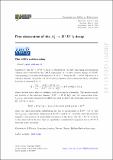First observation of the Λ0𝑏 → D+D−Λ decay
Author(s)
Aaij, R.; Abdelmotteleb, A. S. W.; Abellan Beteta, C.; Abudinén, F.; Ackernley, T.; Adams, J. A.; Adefisoye, A. A.; Adeva, B.; Adinolfi, M.; Adlarson, P.; Agapopoulou, C.; Aidala, C. A.; Ajaltouni, Z.; Akar, S.; Akiba, K.; Albicocco, P.; ... Show more Show less
Download13130_2024_Article_23977.pdf (870.4Kb)
Publisher with Creative Commons License
Publisher with Creative Commons License
Creative Commons Attribution
Terms of use
Metadata
Show full item recordAbstract
The Λ0𝑏
→ D+D−Λ decay is observed for the first time using proton-proton collision data collected by the LHCb experiment at a center-of-mass energy of 13 TeV, corresponding to an integrated luminosity of 5.3 fb−1. Using the B0 → 𝐷+𝐷−𝐾0𝑆
decay as a reference channel, the product of the relative production cross-section and decay branching fractions is measured to be
=σΛ0𝑏σ𝐵0=(Λ0𝑏→𝐷+𝐷−Λ)(𝐵0→𝐷+𝐷−𝐾0S)=0.179±0.022±0.014,
where the first uncertainty is statistical and the second is systematic. The known branching fraction of the reference channel, (𝐵0→𝐷+𝐷−𝐾0S)
, and the cross-section ratio, σΛ0𝑏/σ𝐵0
, previously measured by LHCb are used to derive the branching fraction of the Λ0𝑏
→ D+D−Λ decay
(Λ0𝑏→𝐷+𝐷−Λ)=(1.24±0.15±0.10±0.28±0.11)×10−4,
where the third and fourth contributions are due to uncertainties of (𝐵0→𝐷+𝐷−𝐾0S)
and σΛ0𝑏/σ𝐵0
, respectively. Inspection of the D+Λ and D+D− invariant-mass distributions suggests a rich presence of intermediate resonances in the decay. The Λ0𝑏
→ D*+D−Λ decay is also observed for the first time as a partially reconstructed component in the D+D−Λ invariant mass spectrum.
Date issued
2024-07-16Department
Massachusetts Institute of Technology. Department of PhysicsJournal
Journal of High Energy Physics
Publisher
Springer Science and Business Media LLC
Citation
The LHCb collaboration., Aaij, R., Abdelmotteleb, A.S.W. et al. First observation of the Λ0𝑏
→ D+D−Λ decay. J. High Energ. Phys. 2024, 140 (2024).
Version: Final published version
ISSN
1029-8479